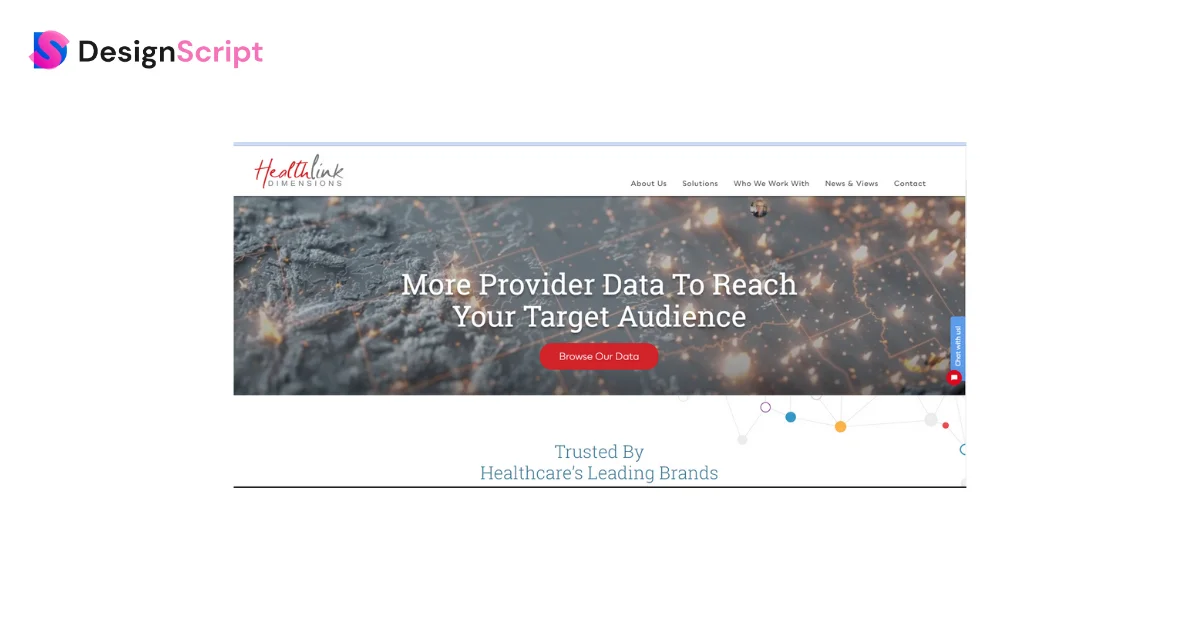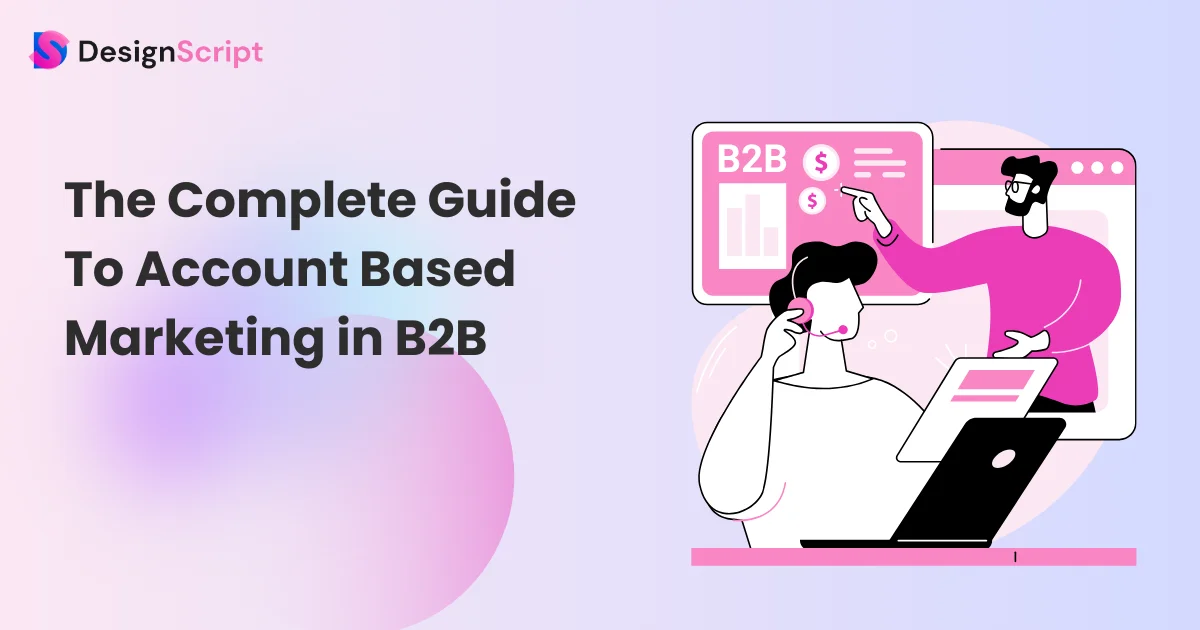The Complete Guide To Account Based Marketing in B2B
Most marketers believe that ABM, i.e., account based marketing in B2B offers excellent value for their investment. 76% of marketers say ABM produces a greater return on investment than any other marketing approach. You’re in the right place if you’re wondering what ABM is and why it matters.
Account based marketing in B2B targets specific companies or accounts with personalized marketing campaigns. It’s like having a one-on-one conversation with your most important customers.
Without ABM, you might miss out on a game-changing strategy that could take your B2B marketing to the next level. You could be wasting time and resources on broad campaigns that don’t deliver the desired results.
Don’t worry, though! In this blog post, we’ll walk you through the ins and outs of account-based marketing in B2B. You will learn how it works, why it’s essential, and how to implement it successfully.
Get ready to unlock the power of account-based marketing in B2B and supercharge marketing efforts.
Let’s begin!
Table of Contents
- What is Account-Based Marketing in B2B?
- History of Account-Based Marketing
- Benefits of Account Based Marketing in B2B
- What are the Types of Account-Based Targeting?
- Difference Between Account Based Marketing & Lead Generation
- How Does Account-Based Marketing Work?
- Creating an ABM Strategy
- Account Based Marketing Tactics
- 1. Use a Strategic Account Planning Template
- 2. Secure Organizational ABM Alignment
- 3. Build Your ABM Team
- 4. Identify the Ideal Set of Target Accounts
- 5. Align Marketing and Sales to Build Plans
- 6. Attract Contacts from High-Quality Accounts
- 7. Build Strong Relationships with the Account’s Buying Committee
- 8. Measure and Analyze Your ABM Results
- Account Based Marketing Challenges
- Account Based Marketing Examples
- Account Based Marketing Tools
- FAQs
What is Account-Based Marketing in B2B?
Account based marketing is a B2B strategy that sales and marketing teams employ to concentrate their efforts on specific companies or accounts. In ABM, marketing and sales departments collaborate closely, forming a unified revenue team with shared objectives. They identify a select group of key accounts and collaborate to secure more business.
In contrast to traditional inbound strategies, such as content marketing or lead-based marketing, where you cast a wide net and hope for responses, ABM is all about focusing on specific individuals within a target account and aligning marketing efforts with the sales team.
Instead of trying to reach many people at once, ABM makes content that’s just right for specific folks in companies you want to partner with.
History of Account-Based Marketing

The history of Account Based Marketing goes back to the 1990s when both B2C and B2B businesses started realizing the importance of personalized marketing.
You might recall a book called “The One to One Future” by Don Peppers and Martha Rogers, published in 1993. It predicted the shift from mass marketing to the personalized marketing we see today. As consumers began to seek more customized buying experiences, many marketers began using account-based marketing techniques to meet these demands.
The term “account based marketing” was officially coined in 2004 by the ITSMA ABM certification program. However, many companies have been using similar strategies in some form for years. Only recently, ABM gained more popularity in the B2B marketing industry due to a stronger focus on demand generation, return on investment (ROI), and the availability of better ABM solutions from various vendors.
Benefits of Account Based Marketing in B2B

Let’s explore the benefits of account-based marketing in B2B:
1. Keeping Marketing and Sales Aligned
ABM promotes close collaboration between marketing and sales teams. Both departments work together towards a shared goal by targeting specific accounts. This alignment ensures that marketing efforts are tailored to the sales team’s needs, resulting in more effective campaigns and a more efficient sales process.
2. More Consistent Customer Experiences
ABM allows for the delivery of consistent and highly personalized messages to target accounts. This consistency across various touch points fosters a cohesive and memorable customer experience. When a prospect encounters a unified message and experience from your company, it builds trust and enhances your brand’s reputation.
3. Increasing ROI
One of the primary benefits of ABM is its ability to deliver a higher return on investment (ROI) compared to traditional marketing methods. Concentrating resources on a select group of high-potential accounts makes you more likely to convert those accounts into customers. The focused and personalized approach maximizes your marketing dollars’ effectiveness.
4. Streamlining Sales Cycles
ABM can significantly reduce the length of sales cycles. Targeting accounts that fit your offerings well eliminates the need to chase after uninterested prospects. This efficiency translates into faster deal closures and reduced resource wastage.
5. Increasing Content Relevance and Customer Trust
In ABM, content is generated with a specific audience in mind. It means the content resonates with your target accounts’ unique challenges and goals. As a result, prospects are more likely to engage with and trust the content, as it directly addresses their needs.
6. Enhancing Account Engagement
ABM helps you build deeper relationships with target accounts. You can understand their pain points and preferences through personalized interactions, enabling you to tailor your communications and solutions accordingly. It leads to higher engagement and a greater likelihood of conversion.
Account based marketing in B2B offers a multitude of benefits for B2B organizations. The ABM strategy is crucial for companies as it aligns sales and marketing efforts, ensuring a united approach to target accounts.
ABM campaigns, designed to resonate with specific leads within these accounts, deliver consistent customer experiences and significantly boost ROI. This approach also speeds up sales cycles, enhances content relevance, and fosters account engagement. As a result, companies leverage ABM to improve profits and build robust and lasting client relationships, solidifying the connection between sales, marketing, and their most valued target accounts.
What are the Types of Account-Based Targeting?
Account based marketing in B2B employs various targeting approaches to engage high-value accounts effectively. Here are three prominent types:
1. Strategic ABM (One-to-One ABM)
Strategic ABM (One-to-One ABM) is a special way of doing account-based marketing (ABM). In this method, you focus on just a few important accounts, usually between one and five. You create super-personalized marketing plans for each of them. It’s a lot of hard work because the sales, marketing, and management teams need to work closely together. They want to sell more to these special accounts, and this approach helps with that.
To do this type of ABM, you need to know what the perfect customer looks like for your business. Building strong relationships with these special customers takes time. Account based marketing managers are the people who make all of this happen. They’re like the ship’s captains, leading the way and ensuring everything goes according to plan. These jobs involve creating and carrying out an account-based marketing strategy, managing the list of special accounts, using different tactics, and ensuring everything works well.
2. Marketing ABM (One-to-Few ABM)
Marketing ABM, also known as One-to-Few ABM, is a bit different. Instead of focusing on just a few accounts, it looks at a slightly larger group. These accounts usually have something in common, like being in the same industry. It’s still about making things personal, but it’s more flexible than the super-personal approach of Strategic ABM.
Account based marketing managers in these jobs work on making customized plans that are broader but still special for these accounts. It is a great choice when you have quite a few accounts to deal with but still want to give them a personalized experience. It’s like finding a balance between personalization and managing more accounts effectively. This type of ABM is all about using different strategies and tactics to connect with these accounts in the best way possible.
3. Programmatic ABM (One-to-Many ABM)
Programmatic ABM, also known as One-to-Many ABM, is a broader approach. Instead of focusing on just a few accounts, it looks at a larger group that shares some things in common. It’s like trying to catch more fish with a bigger net.
Here, there is the use of technology and smart data to make things work. It’s like having a robot helper. This robot helps the marketing teams reach out to lots of accounts at the same time. It’s efficient because it can do things automatically. They make sure the messages are still special for each group of accounts.
So, Programmatic ABM is like using digital marketing with some magic. It helps marketing teams run big campaigns and reach many accounts without doing everything by hand. It is a way to be smart and effective in marketing, especially when you have a lot of accounts to take care of.
Difference Between Account Based Marketing & Lead Generation
Account based marketing in B2B and lead generation are two distinct approaches in the world of marketing, each with its focus and objectives. Let’s see how they differ:
Account Based Marketing
ABM is like a laser beam, where you precisely target a select few high-value accounts or companies. It’s all about quality over quantity. Instead of casting a wide net, you customize your marketing efforts for specific target accounts. Account based marketing in B2B is highly personalized, tailoring content and messages to resonate with each account’s unique needs and challenges.
ABM tools and marketing software are essential in this approach to help manage and automate personalized campaigns effectively. Rather than following the traditional marketing funnel, ABM builds relationships and nurtures accounts over time. It’s a strategic, long-term play to win over key accounts and grow customer loyalty.
Lead Generation
Lead generation, on the other hand, is more like fishing with a net. It’s about capturing as many potential customers as possible from a broader audience. Here, the focus is on quantity, casting a wide net to attract more leads. Content marketing often plays a significant role in lead generation, creating content that appeals to a broader target audience.
In lead generation, you use marketing strategies to gather contact information and generate interest in your product or service. The marketing funnel is a central concept, guiding prospects from awareness to consideration and, ideally, conversion into customers.
How Does Account-Based Marketing Work?
Let’s explore how account-based marketing in B2B works:
- Integration with CRM and Marketing Automation: ABM solutions seamlessly merge with Customer Relationship Management (CRM) and marketing automation systems. It enables the ABM team, led by a marketing manager, to run targeted campaigns for specific accounts.
- Reach Beyond Your Database: ABM technology extends your reach beyond your contacts in your database. It allows you to connect with other key decision-makers within your target accounts.
- Multichannel Campaigns: ABM tech empowers you to run multichannel campaigns, which means you can reach your target audience through various channels like mobile, social media, display ads, and video. This broader engagement approach makes ABM scalable and effective in reaching the entire account, not just individual leads.
- A/B Testing: ABM technology facilitates A/B testing in near real-time. It means you can experiment with different ad creatives and messages to understand what resonates the most with your target audience and gather data to support your decision.
- Personalization at Scale: ABM software allows personalized marketing across different buyer personas, sales stages, campaigns, or CRM statuses. This versatility makes engaging and nurturing your target buyers easier wherever they are online.
- Highly-Targeted Messaging: ABM delivers messages to specific accounts, ensuring a personalized buying experience. It’s a departure from the one-size-fits-all approach and has become a vital strategy for modern marketing teams.
When evaluating ABM software, choosing a platform and partnership that aligns with your ABM strategy and the goals set by the marketing manager and the account management team is essential.
Creating an ABM Strategy
Creating a successful ABM strategy is like following a well-thought-out plan. Here are the key steps in simple terms:
1. Identify Target Accounts
First, you figure out which companies or clients you want to work with. These are your “dream” accounts. It’s like making a list of your favorite things.
2. Rank Prospects in Your Target Accounts
You find the most important people for making decisions in those dream accounts. It’s like picking the captain of a sports team; they have a big say in what happens.
3. Keep Marketing and Sales Aligned
It’s super important that the marketing and sales teams work together. They need to be on the same page to make the plan work. Imagine a team of superheroes – they’re more powerful when they work as one.
4. Create Personalized Content
You make special messages and content for those dream accounts. It’s like writing a letter to your best friend, speaking directly to what they like and need.
5. Measure Results
Finally, you see how well your plan is working. You use numbers and data to determine what’s going well and what needs improvement. It’s like checking the score in a game to see if you’re winning.
By following these steps, you can ensure your ABM strategy effectively generates leads and builds strong, lasting relationships with your ideal customers profile.
Account Based Marketing Tactics
Account based marketing tactics is like a well-structured playbook for businesses focusing their marketing efforts on specific target accounts. In simple terms, let’s explore these strategies step by step:
1. Use a Strategic Account Planning Template

Consider this your game plan. Like a sports team has a strategy, your ABM team needs a plan. You use a template to outline your goals, who you’re targeting, and how you’ll win them over. It’s like drawing a map before going on an adventure.
2. Secure Organizational ABM Alignment

Everyone in your company must be on the same page. It’s like making sure all your teammates know the game plan. It’s a winning formula when your marketing and sales teams work together towards the same goal.
3. Build Your ABM Team

Think of your ABM team as your superheroes. They’re the ones who’ll execute the plan. It would help to have skilled professionals to create and manage marketing campaigns. It’s like assembling a team of experts to win the championship.
4. Identify the Ideal Set of Target Accounts

You can only win if you know who you’re playing against. In ABM, you carefully select the accounts you want to win over. These are your dream clients who are the best fit for your business.
5. Align Marketing and Sales to Build Plans

Marketing and sales are dynamic. They need to work closely together. Imagine Batman and Robin fighting crime together. Marketing creates the right messages and materials, while sales takes them to the target accounts.
6. Attract Contacts from High-Quality Accounts

You want to get the attention of the important people in your target accounts. It’s like inviting them to a special event. You use digital marketing and other tactics to make sure they notice you.
7. Build Strong Relationships with the Account’s Buying Committee

ABM is not just about one person. It’s like impressing the whole board of directors. It would help if you connected with all the key decision-makers in your target accounts.
8. Measure and Analyze Your ABM Results

You need to know if you win in a game. You use data and numbers to see how well your plan is working. If something isn’t going right, you can change your tactics.
These ABM tactics are like a winning strategy for your business. They involve your marketing and sales teams working to attract and build relationships with the most important accounts. By following these steps and constantly improving your approach, you can score big in account based marketing in B2B and achieve your business goals.
Account Based Marketing Challenges

Account based marketing in B2B offers many benefits, but it also comes with its fair share of challenges, especially when compared to traditional marketing methods.
- Limited Target Account List: In ABM, you focus on several high-value accounts. It can be challenging because you might miss out on potential leads outside your chosen list.
- Resource Intensive: ABM demands more resources and time from your ABM team and your marketing manager. It’s like running a marathon instead of a race.
- Specialized ABM Tools: You need specialized ABM software and tools to execute ABM effectively. These tools can be expensive and require training for your team.
- Complexity in Measurement: Measuring success in ABM is more complex than in traditional marketing. You have to track the engagement of multiple stakeholders in each account, making it a bit like solving a puzzle.
- Alignment of ABM Team: Your ABM team must work closely with your sales team, and ensuring they are aligned can be a challenge. It’s like ensuring all the players on a sports team are on the same page.
- Content Personalization: Creating highly personalized content for each account can be time-consuming. It’s like writing a unique letter to every person you want to connect with.
- Longer Sales Cycle: ABM often involves dealing with larger and more complex accounts, leading to longer sales cycles than traditional marketing.
Account Based Marketing Examples
Now that you know the basics of account based marketing in B2B, let’s look at real-life examples of how it has benefited businesses.
Example 1: Restaurant Furniture Plus

Restaurant Furniture Plus used to depend on people finding their website through Google search or paid ads. But they realized they wanted to work with big restaurant chains, so they changed their approach. They started using account-based marketing to reach out to restaurant owners who fit their products well. This way, they saved money on paid ads and gained more customers who returned for their furniture.
Example 2: HealthLink Dimensions

HealthLink Dimensions, a company dealing with healthcare data, joined forces with the marketing agency Acclaro to try account-based marketing. Their goal was to offer more services to health insurance providers. However, they faced a problem: they needed help to get new contacts interested in what they had to offer.
They teamed up with Acclaro to use an account based marketing strategy to solve this issue. The result? Their pipeline of potential new customers grew by a whopping 234%.
Account Based Marketing Tools
Let’s explore the account based marketing tools:
1-HubSpot ABM Software
Setting up your ABM strategy with HubSpot tools is easy and quick. You can use templates to create profiles for your ideal customers and pick the right accounts. HubSpot also uses smart suggestions to help you find the best accounts for sales. Everything happens in one place so that you won’t lose important information about your customers and leads between marketing and sales teams. It’s like having a handy tool that ensures you’re always organized and on top of things.
2-Terminus
Terminus is a tool that gives you everything you need for ABM. You make lists of accounts and get all the info to make your plans special. With Terminus, you find where the accounts are and send them messages. You can do things like show ads again, use automation, and send emails all in one place. You can also see how well your plans work with the numbers it gives you. It helps you figure out how to do even better with your accounts. Key features include making account lists, managing campaigns, and looking at the numbers to see how things are going.
Unlock the power of ABM
In this journey through account based marketing, we’ve explored how this personalized approach can supercharge your marketing efforts. Account based marketing in B2B is all about focusing on the right accounts, creating tailored strategies, and building lasting relationships. Whether using HubSpot’s intuitive tools or leveraging Terminus for full-service support, ABM offers a path to greater efficiency and ROI. We hope you’ve gained valuable insights into this powerful strategy and are ready to embark on your ABM adventure.
Remember, Account based marketing in B2B is about making your customers feel special, and we hope you’ve felt the same way on this ABM journey with us.
FAQs
Account-based marketing in B2B is important because it enables personalized and targeted outreach, fostering stronger relationships with key accounts and improving the likelihood of conversion.
You can implement ABM by identifying target accounts, aligning sales and marketing, creating personalized content, and measuring results. It’s essential to continually refine and adapt your ABM strategy based on the insights gained from measuring and analyzing the campaigns.
An ABM platform is software that helps execute and manage account-based marketing strategies, facilitating personalized outreach to target accounts. Additionally, they often provide analytics and reporting features to measure the effectiveness of ABM campaigns.

